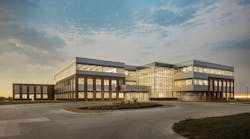Moisture design tips for ice rinks
| This special report is the fourth installment of a six-part series from Sean O'Brien on moisture-related design for specialty buildings. The series includes: • Indoor swimming pools/natatoriums • Museums and archives • Hospitals • Ice rinks • Cold storage facilities • Indoor ski parks | |
There are three primary types of ice rinks: conditioned, partially conditioned, and unconditioned. These loosely correspond to three primary construction types: fully enclosed, partially enclosed, and open. Depending on the type of building enclosure, the ice surface may be kept frozen either by a matrix of cooling pipes in the slab below the ice (in the case of fully enclosed rinks) or via natural low temperatures during the winter months (more typical of open rinks).A fully enclosed ice rink is likely to have insulated walls and roofs, as well as mechanical systems that are capable of both heating and cooling. Fully enclosed ice rinks are also more likely to have some type of ventilation and dehumidification capabilities, allowing for tighter control over interior conditions. This control is especially necessary in venues such as professional hockey arenas that draw large crowds of spectators. Without adequate mechanical systems, the thermal and moisture loads from building occupants would be unmanageable, leading to high interior temperature and relative humidity levels.The interior conditions and design of the mechanical system must be balanced with the refrigeration system for the ice surface, as heat added to the space will eventually need to be taken out by the refrigeration system to maintain the ice at the desired temperature.Partially enclosed ice rinks may have a complete building enclosure in the sense of having four walls and a roof, but may not be insulated or contain open or louvered wall areas.
| Ice rink design guidelines The following must be considered when designing ice rinks: • Design building mechanical systems with heating, cooling, and dehumidification capacities based on accurate building enclosure performance criteria, occupant load estimates, and seasonal operating schedule. • Coordination between mechanical engineers and building designers is critical to achieving a successful, integrated design. • Establish the intended operating schedule for the building (e.g., year-round, winter only, etc.) to assess the likelihood of condensation and frost heave problems. • Evaluate the risk of frost heave by determining the susceptibility of the local soils and the depth of frost penetration below the slab. Where appropriate, design heating pipes or a ventilated crawlspace to prevent frost heaving below the ice surface. • Evaluate the need for low-emissivity materials/coatings for building components above the ice surface based on ice temperature and expected interior relative humidity levels. | |
When designers think of condensation problems in buildings, the sight of water dripping from window frames or skylights often comes to mind. In ice rinks, condensation manifests itself somewhat differently, often to the surprise of architects and engineers.The first condensation problem found in ice rinks occurs due to a combination of high relative humidity levels, low surface temperatures on the ice, and stagnant air near the ice surface. Since the ice temperature will also determine its hardness, the ideal ice surface temperature depends on the use of the facility (i.e., competitive hockey, recreational skating, etc.) at a given point in time. Typical ice surface temperatures range from approximately 22°F to 28°F.Under the right circumstances, moisture in the interior air may begin to condense just above the surface of the ice, not unlike the formation of clouds in pockets of cold air. This produces a blanket of fog over the ice surface. Although not necessarily detrimental to the building itself, heavy fogging can render an ice rink facility unusable for its intended purpose. A famous example of fogging is the old Boston Garden, where dense fog over the ice made for interesting play and angry fans during the playoffs.A properly designed mechanical system is the key to preventing fogging near the ice by providing humidity control and possibly air circulation near the ice surface. Such a system must be designed to consider both prevention of condensation and energy efficiency, as excessive airflow over the ice may create unnecessary loads on the refrigeration system. The second condensation problem can occur far from the ice surface, but still directly above it. Objects in a building will always radiate heat to surfaces at lower temperatures. Since the ice surface is generally the coldest surface in the building, nearly all surfaces in the building will radiate heat to the ice surface, reducing their surface temperatures (Figure 1).Figure 1. Heat loss from warm ceiling to ice rink surfaceThis cooling effect is greatest on components with direct line of sight to the ice, typically the roof construction. The cooling effect of the ice will vary depending on the amount of roof insulation as well as the interior temperature, but can reduce surface temperatures by 10°F or higher. If combined with high enough interior humidity, undercooling of the ceiling structure can cause condensation, resulting in water dripping onto the ice surface. Dripping water can quickly create bumps and irregularities on the ice surface that may pose a hazard to skaters and a nuisance to spectators.Condensation control can be achieved in two ways. The first is to maintain interior relative humidity levels below the condensation threshold. This is a feasible solution only in buildings with capable mechanical systems, and is generally not an option for open or partially enclosed rinks.The second is maintaining interior surface temperatures of the building enclosure above the dew point temperature of interior air by reducing radiative heat transfer to the ice. This can be accomplished by using low-emissivity paints or barriers on or below the ceiling structure. Foil barriers are typically more effective, but less aesthetically pleasing, than applied coatings (Photo 1). Photo 1. Low-emissivity barrier (foil sheet) used to reduce heat loss from ice rink ceilingJust as low-emissivity, or “low-e,” coatings on insulating glass units can reduce heat gains due to solar radiation, they can be used to reduce radiation from ceiling structures to the cold ice surface below (Figure 2). The type of low-e product used will depend on the potential severity of the condensation problem and the expected interior humidity levels. Another benefit of low-e ceilings is that, by reducing radiative heat transfer from the ceiling (often the underside of the roof) to the ice surface, the refrigeration load for the ice surface will be reduced Figure 2. Heat loss to ice surface reduced with low-emissivity coating (green dotted line) FROST HEAVE In addition to creating condensation problems, the frozen ice surface can create problems below the building. In a typical heated or partially conditioned building, the ground below the occupied space is kept relatively warm (i.e., above freezing) by heat loss from the interior space. This is true even in buildings with insulated floor slabs (Figures 3 and 4). Figure 3. Temperature profile and frost line below heat building with uninsulated slab Figure 4. Temperature profile and frost line below heat building with R-10 insulated slabIn an ice rink, where the slab surface is below freezing, no such soil heating occurs and the ground below the building may freeze (Figure 5). Depending on the local soil and groundwater conditions, and the ice rink’s operating seasons, frost heave may occur in the soil below the rink surface. Figure 5. Temperature profile and frost line below ice rink The exact mechanisms of frost heave are complex, but the essential process is simple: As water accumulates and freezes in the soil, the resulting volumetric expansion (approximately 9%) “pushes” or exerts an upwards force on the slab (Figure 6). Heaving soils can exert sufficient pressure on the slab to cause cracking and displacement. Such damage could render the rink unusable and require costly repairs, especially if the cooling matrix for the ice is damaged. This is in contrast to the problems previously discussed, which affect the operation of the building but not the building itself. Figure 6. Schematic diagram of frost heave below ice rinkSub-slab insulation alone may not be sufficient or may need to be installed in thicknesses too large to be practical in preventing frost heave. Some type of supplemental heating, such as heating pipes or cables, is often necessary to prevent long-term freezing of the ground below the rink surface.An alternative, though somewhat more complex, is to create a crawlspace between the ice and the ground and to ventilate that space with heated air. It should be noted that frost heave is less likely occur if an ice rink operates for only part of the year, as seasonal thawing of the ground may prevent long-term ice accumulation. The seasonal use of the building and the associated risk of frost heave must be evaluated during the design process.
Sean O’Brien is a Senior Project Manager in the New York City office of Boston-based Simpson Gumpertz & Heger Inc. O’Brien specializes in building science and building envelope performance, including computer simulation of heat, air, and moisture migration issues. He has investigated and designed repairs for a variety of buildings types, from condominiums to art museums, and has published papers on topics including moisture migration in masonry wall systems and condensation resistance of windows and curtain walls. He can be reached at [email protected].

